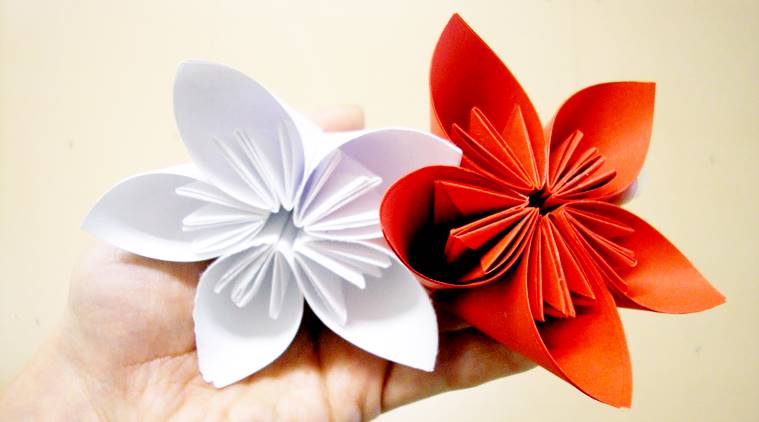
Origami Book Reviews Here are 487 short reviews and model listings of a selection out of over 3,000 origami books and publications in my collection. You can sort the table by clicking on column headers, or filter the list by typing in the filter box. Title Author Year Where to Buy* Takai Hiroaki 2007 Peter Engel 2009 Vietnam Origami Group 2011 Mari Kanegae 1997 Florence Temko 2011 Taichiro Hasegawa 1997 Rick Beech 2002 Michael G. LaFosse and Richard L. Alexander 2005 John Montroll 1991 Akira Yoshizawa 2016 Akira Yoshizawa 1999 Yamada Katsuhisa 2008 John Montroll 1985 Madiyar Amerkeshev 2009 Joel Stern 2007 Richard Saunders, Campbell Morris and Brian Mackness 1988 Tem Boun 2005 Tem Boun 2007 John Montroll 1995 David Brill 1996 John Montroll 1999 John Montroll 2001 Robert Neale 1964 Carlos Gonzalez Santamaria (Halle) 2001 Carlos Gonzalez Santamaria (Halle) 2002 Carlos Gonzalez Santamaria (Halle) 2002 John Montroll 2006 Paul Jackson 1990 Katrin and Yuri Shumakov 2009 David Mitchell 2009 Eric Kenneway 1987 2011 J.C. Nolan 2012 Seo Won Seon and Lee In Kyung (Red and White Paper) 2007 Marc Kirschenbaum 2016 Assia Brill 2013 Kunihiko Kasahara 2008 David Brill 2005 John Montroll 2015 Peter Budai 1993 John Montroll 2010 Fernando Gilgado Gomez 2001 Alfredo Giunta 1992 Toshikazu Kawasaki 2006 John Montroll 2000 John Montroll 2003 Won Park 2011 Yoshihide Momotani 2001 Taichiro Hasegawa 2004 Tom Stamm 1993 Sergei Afonkin and Elena Afonkina 2001 Mario Adrados Netto and Jose Anibal Voyer 2005 Halle, Pere Olivella and Nicolas Terry 2014 Tammy Yee 2015 John Montroll 2006 Anita F.
Origami Designer's Secrets: Riccardo Foschi. By Ilan Garibi. Bentuk bentuk strategi menurut kotler keller williams realty. Edited by Patsy Wang-Iverson. Also, I love the community which is small but super polite, kind and sharing-based. I always thank my mother who introduced me to the art of folding. And I follow the rules explained in the book Origami Design Secrets.
Barbour 2004 Grupo Riglos 1997 Grupo Riglos 1990 Sergei Afonkin and Elena Afonkina 2000 Eric Joisel 2011 Eric Joisel 2010 Steve and Megumi Biddle 1991 Julian Gonzalez 2000 Paul Frasco 2017 John Montroll 1996 Jozsef Zsebe 2012 2005 Makoto Yamaguchi 2000 Jun Maekawa 2012 Jun Maekawa 2012 Jun Maekawa 2008 Jun Maekawa 2009 Nick Robinson 2012 Kunihiko Kasahara 2002 John Montroll 2013 Fumiaki Kawahata 1997 Lionel Albertino 2001 2004 Issei Yoshino 1996 Michael G. LaFosse 2014 Joel Stern 2006 Kunihiko Kasahara 1996 Michael G. LaFosse and Richard L. Alexander 2016 Nicolas Terry 2008 Hatje Cantz 2005 Michael G. LaFosse and Richard L. Alexander 2013 1988 Ekaterina Lukasheva 2015 Ekaterina Lukasheva 2016 Yoshihide Momotani 2001 Fernando Gilgado Gomez 1998 Joel Stern 2013 Kunihiko Kasahara 2002 John Montroll 1996 Dave Venables 2002 Meher McArthur 2017 Nick Robinson 2016 John Montroll 1995 Paulo Mulatinho 1995 Rick Beech 2001 David Petty 2002 Robert Harbin 1971 Robert Harbin 1977 John Szinger 2014 Robert J. Lang 1992 Michael G.

LaFosse and Richard L. Alexander 2008 Richard L. Alexander and Greg Mudarri 2006 Joel Stern 2017 Shuki Kato and Jordan Langerak 2015 1989 2001 2011 Robert J.
Lang 2011 Yamada Katsuhisa 2006 Fumiaki Kawahata 2001 Fumiaki Kawahata 2003 Yasuhiro Sano 1979 Toshikazu Kawasaki 2001 Toshikazu Kawasaki 2003 Kunihiko Kasahara 1989 Roman Diaz 2009 2014 Fumiaki Kawahata 1995 Michael G. LaFosse and Richard L. Alexander 2014 Yehuda Peled 2015 Ioana Stoian 2013 2013 Roman Diaz 2006 Kunihiko Kasahara and Toshie Takahama 1985 John Montroll 1979 Peter Engel 1994 Joel Stern 2010 Alfredo Giunta 1987 Ronald Koh 2002 Alfredo Giunta 1989 Lew Rozelle 1997 Fumiaki Kawahata and Seiji Nishikawa 2000 Robert J. Lang 1993 Robert J.
Lang 1995 John Montroll 1993 Nick Robinson 2008 Kunihiko Kasahara 1989 Kunihiko Kasahara 1973 2003 Jay Ansill 1992 Peter Engel 2011 Kunihiko Kasahara 1988 Eric Kenneway 1980 Fuchimoto Muneji 2011 John Montroll 1990 John Montroll and Robert J.
When it comes to technical origami designs, by Robert Lang is a must have. This 500+ page book is not like other origami books. Instead of showing you how to fold origami models, it teaches you techniques so that you can create your own models. There are a few diagrams, but these are included as an exercise to reinforce the discussed techniques. What are some of these techniques? Splitting Points: Here, Robert Lang explains how a 'flap' (an origami crane has 4 'flaps: two wings, one head and one tail) can be divided into more flaps. Thus, a head can be converted into a head with a beak.
A leg can be converted to a leg with toes. The flash movie download free. [Photo: Goatfish uses point splitting to create a head with a lower jaw and two barbels. Folded by.] Grafting: The idea behind grafting is to add extra strips of paper so that you can use the extra paper to make a more detailed or better model. In reality, you don't add strips of paper: you simply use a larger piece of paper. Some of the paper will be reserved for the original design and the extra paper will be used to for the elements you want to add. [Photo: Western Pond Turtle uses grafting to create the pattern on the shell.